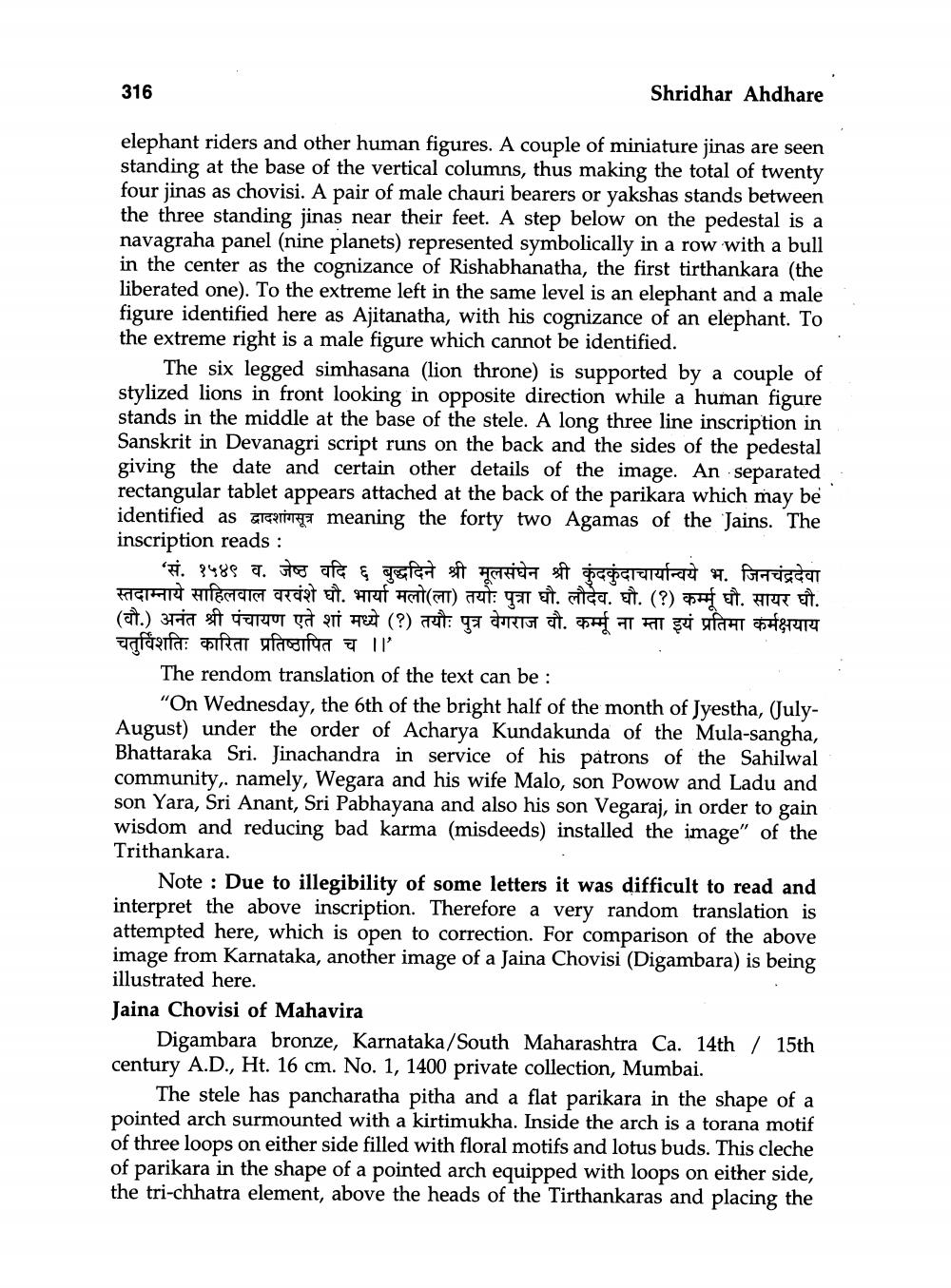________________
316
Shridhar Ahdhare
elephant riders and other human figures. A couple of miniature jinas are seen standing at the base of the vertical columns, thus making the total of twenty four jinas as chovisi. A pair of male chauri bearers or yakshas stands between the three standing jinas near their feet. A step below on the pedestal is a navagraha panel (nine planets) represented symbolically in a row with a bull in the center as the cognizance of Rishabhanatha, the first tirthankara (the liberated one). To the extreme left in the same level is an elephant and a male figure identified here as Ajitanatha, with his cognizance of an elephant. To the extreme right is a male figure which cannot be identified.
The six legged simhasana (lion throne) is supported by a couple of stylized lions in front looking in opposite direction while a human figure stands in the middle at the base of the stele. A long three line inscription in Sanskrit in Devanagri script runs on the back and the sides of the pedestal giving the date and certain other details of the image. An separated. rectangular tablet appears attached at the back of the parikara which may be identified as GERITET meaning the forty two Agamas of the Jains. The inscription reads:
_ 'सं. १५४९ व. जेष्ठ वदि ६ बुद्धदिने श्री मूलसंघेन श्री कुंदकुंदाचार्यान्वये भ. जिनचंद्रदेवा स्तदाम्नाये साहिलवाल वरवंशे घौ. भार्या मलो(ला) तयोः पुत्रा घौ. लौदेव. घौ. (?) कर्मू घौ. सायर घौ. (वौ.) अनंत श्री पंचायण एते शां मध्ये (?) तयौः पुत्र वेगराज वौ. कर्मू ना म्ता इयं प्रतिमा कर्मक्षयाय चतुर्विंशतिः कारिता प्रतिष्ठापित च ।।।
The rendom translation of the text can be :
"On Wednesday, the 6th of the bright half of the month of Jyestha, (JulyAugust) under the order of Acharya Kundakunda of the Mula-sangha, Bhattaraka Sri. Jinachandra in service of his patrons of the Sahilwal community, namely, Wegara and his wife Malo, son Powow and Ladu and son Yara, Sri Anant, Sri Pabhayana and also his son Vegaraj, in order to gain wisdom and reducing bad karma (misdeeds) installed the images of the Trithankara.
Note : Due to illegibility of some letters it was difficult to read and interpret the above inscription. Therefore a very random translation is attempted here, which is open to correction. For comparison of the above image from Karnataka, another image of a Jaina Chovisi (Digambara) is being illustrated here. Jaina Chovisi of Mahavira
Digambara bronze, Karnataka/South Maharashtra Ca. 14th / 15th century A.D., Ht. 16 cm. No. 1, 1400 private collection, Mumbai.
The stele has pancharatha pitha and a flat parikara in the shape of a pointed arch surmounted with a kirtimukha. Inside the arch is a torana motif of three loops on either side filled with floral motifs and lotus buds. This cleche of parikara in the shape of a pointed arch equipped with loops on either side, the tri-chhatra element, above the heads of the Tirthankaras and placing the




